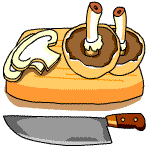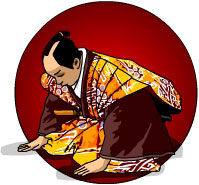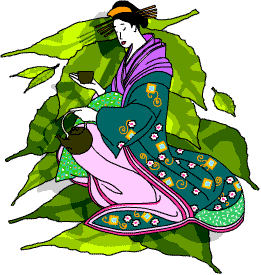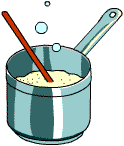The Japanese New Year
Created | Updated Feb 17, 2003
The New Year in Japan is the greatest event of the year, probably the equivalent of the Western Christmas. Unlike the Chinese version, which is in February, it starts on the 1st of January and lasts for 3-7 days. It is regarded as a time for the reunion of families and friends.
Preparation: 271-31 December
Food
Because shops used to be closed during the New Year2, people had to cook enough food that will last for the 3 days without going off. The food is called Osechi-Ryori, which translates to 'Dishes for that season'. It consists of lots of kinds of cooked vegetables, beans, meat and processed fish, flavoured strongly to stop from rotting and packed into boxes. Sometimes the ingredients used are a kind of pun for words like 'well','healthy' or 'away with the demons'.

A typical box may consist of the following:
- Mashed sweet potato with chestnuts
- Sweet black beans
- Little fish flavoured with Soya sauce
- Processed fish cakes
- Egg rolls
- Vegetables, boiled and flavoured with Soya sauce
- Vegetables pickled in vinegar
- Pork in a kind of teriyaki sauce
Decorations
The New Year's decorations are mainly red and gold. People used to put big decorations of bamboo and pine branches tied together with rope on each side of their front gate for this season, but these days the prices have gone up so much that most people put up a smaller version made of pine branches and white paper. The white paper comes from Shinto3shrines, where the gods of the area are said to live.
A common decoration for inside the house is the Kagami-mochi, which is made of rice cakes and an orange stacked to form a sort of snowman shape. This is eaten later in the New Year.
Also, the Japanese do their spring cleaning in December, as part of their ritual to celebrate the New Year.
New Year's Cards
Instead of Christmas cards, people send each other New Year's cards. This is a white postcard with New Year's greetings and maybe pictures of the animal of the year4on it. These days it is popular to do it all on your computer and print your own card. These cards should be sent during December, so the post office can deliver them on the morning of New Year's Day.
However, people are not supposed to celebrate the New Year if someone in their family has died in the past year, so they cannot send or receive cards. Instead they send cards earlier on that say that they are in mourning. People who receive these cards must remember not to send greetings to the sender that year.
New Year's Eve
Noodles are served for supper. Each noodle represents a long life, and therefore should be eaten in one go without biting off in the middle.
Among the many New Year's Eve TV programmes, NHK5's 'Red-versus-white-song-battle' is the all-time favourite. This is a music programme where popular singers of the year divide into the red team (women)and the white team (men), sing their hits of the year and later take votes from the judges and the audience on which team did better.
Around midnight, the local Buddhist temple6 rings their bell (which sounds more like a gong) 108 times, which is supposed to take away worldly desires.

The Real Thing: 1-3 January
People go to Shinto shrines to pray for the year to be a good one. This can be done during the day, but many people go straight after midnight in the dark, many of them to famous shrines in the city. Trains run all night for this event.
In the morning, Japanese sake in tiny plate-like goblets and special tea are both drunk for health, and rice cake in soup is served. By noon, New Year's cards from friends, relatives and acquaintances arrive by post. After this, relatives may come over to celebrate with their boxes of New Year's dishes.

Some people wear kimonos on this day. They usually wear them to shrines and to other people's houses. Mostly women can be seen wearing them.
During the season, the children receive some money from their parents, grown relatives and family friends as a sign of celebration. This can build up to quite an amount, and often lasts for a couple of shopping sprees while the mum attempts in vain to make them put it in the bank.
In the olden days there were many games that were especially played in the New Year; kite-flying, top-spinning, a badminton-like game with wooden rackets, card games and board games being some of them. Outdoor games are now quite difficult to do in the city, what with too little open space and too many electricity wires overhead, but the indoor games are still popular and some schools hold their own card game competitions. They can also be played in family gatherings, and it is quite a sight to see drunken uncles fighting over who got the card first.
It is also traditional to write a piece of New Year's calligraphy. This is written in large handwriting, with a paintbrush-like brush, on a longer piece of paper than usual. The word or phrase written may be something to do with the New Year, or a slogan or short resolution for the coming year. 
Many children have to do it for homework over the school holidays.
7th January
This is the final day of the season, and the last day of the holidays for most schools. Although most shops and companies start working from the 4th, everyone is still in New Year mode for a few days. On this day people cook the 7 herbs of the spring 7in porridge, and yet again wish for a healthy year. The herbs are also good for the stomach, which has had too much strong-flavoured food to digest.11th January
This is the day for eating the said Kagami-mochi,which should have by now been standing on the TV/shelf/mantelpiece for days8. People use a hammer to break the rice cake into pieces and cook it on a kind of barbeque to eat.
But Why All This Fuss?
Up until somewhere like 70 years ago, New Year's day was everybody's official birthday. All babies were counted as 1 year old when they were born, and turned 2 on their first New Year's day9. This made the event not only a celebration of a new year, but also a big birthday party. And being the only festive event in the year, people celebrated it as much as they could.
Of course, traditions differ largely between areas and families, so there exists hundreds of variations.
- Japanese Parsley
- Sheperd's Purse
- Cudweed
- Chickweed
- Japanese Nipplewort
- Turnip
- Japanese Radish
There are also 7 for the autumn, but unlike the ones in spring, they are less weed-like and are not eaten.8Hardened rice cakes last for weeks and they might grow a bit of mould on them but that can be easily washed off and they're still edible. These days they come in plastic packages which keeps them fresh.9 Babies born on the 31st of December would therefore become 2 years old regardless of the fact they were only born the previous day.
